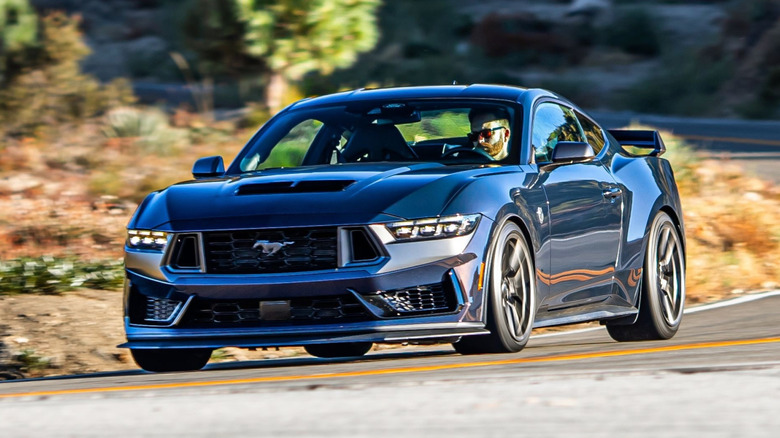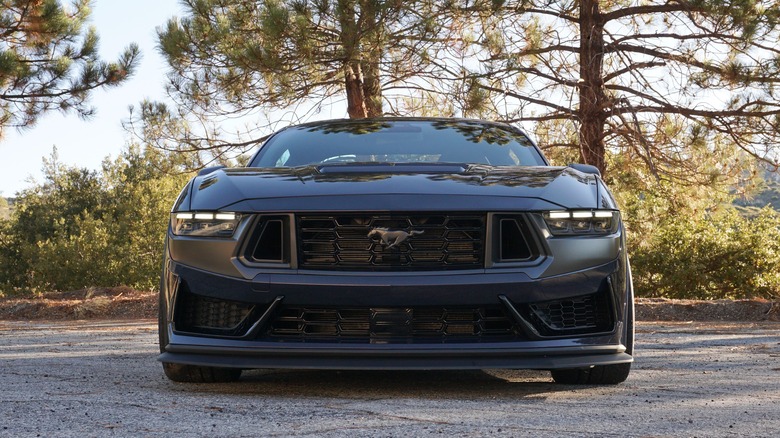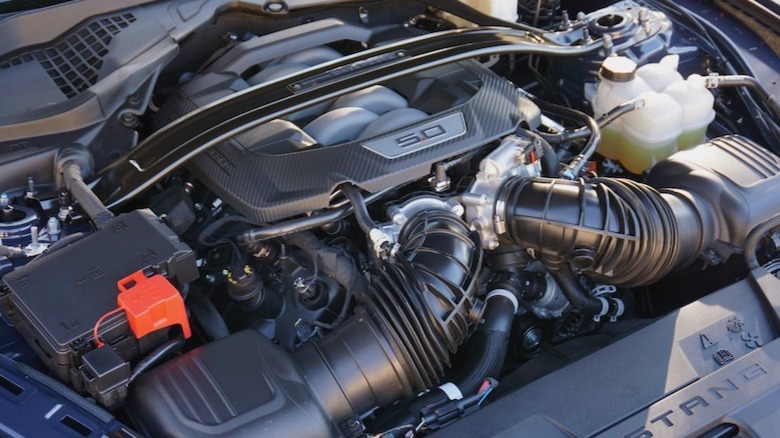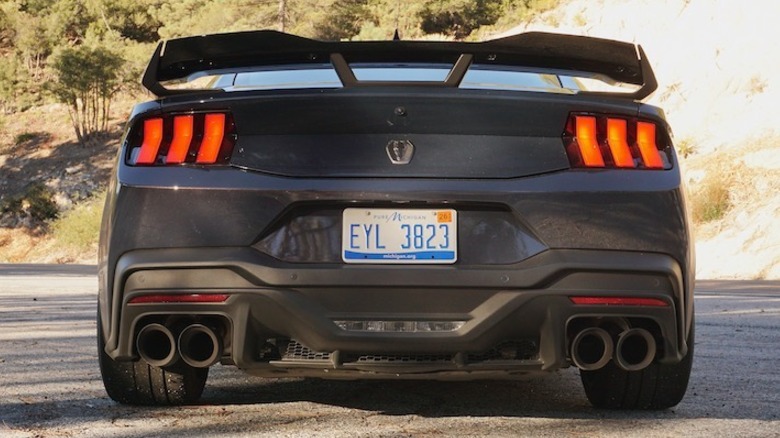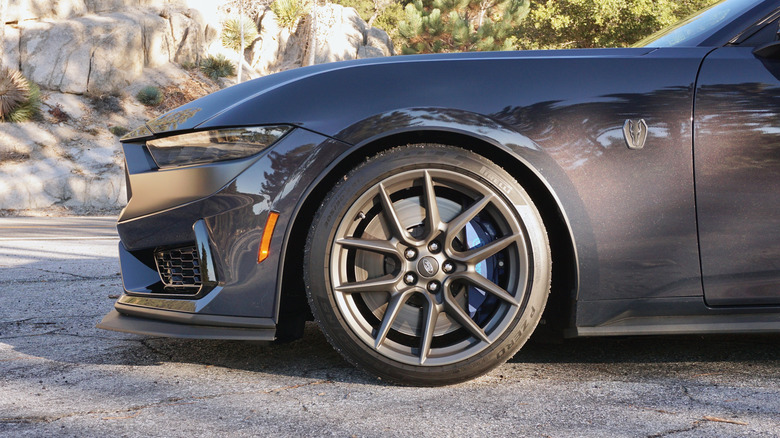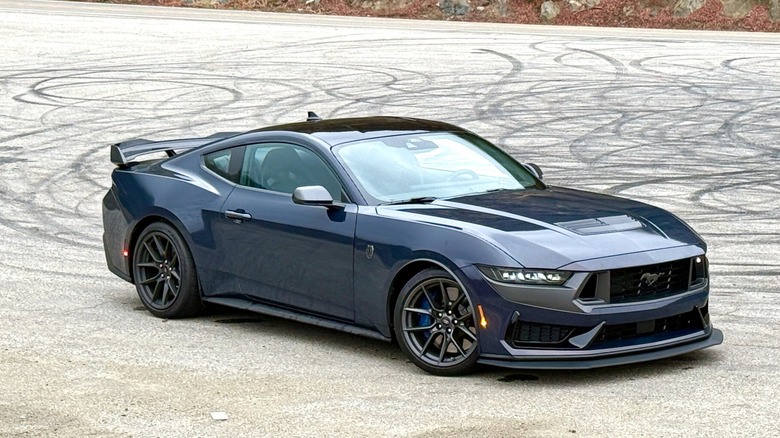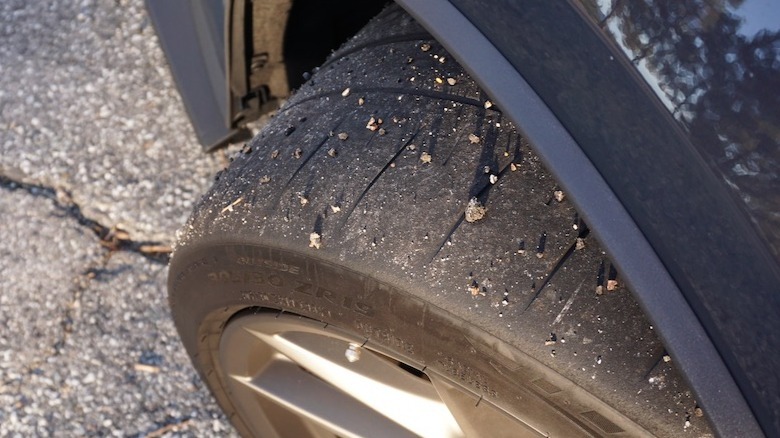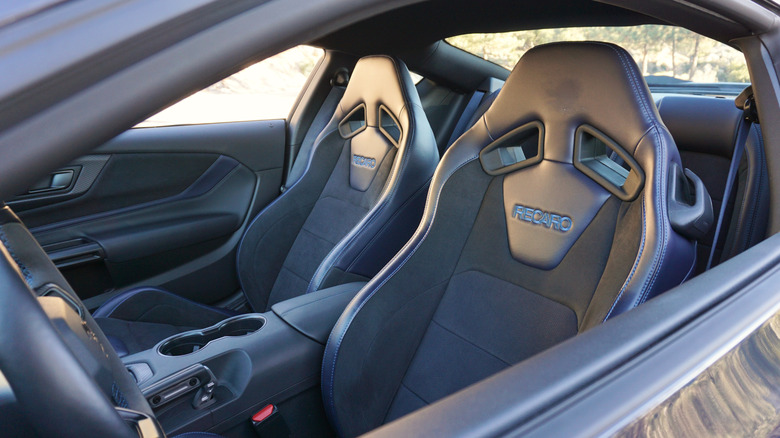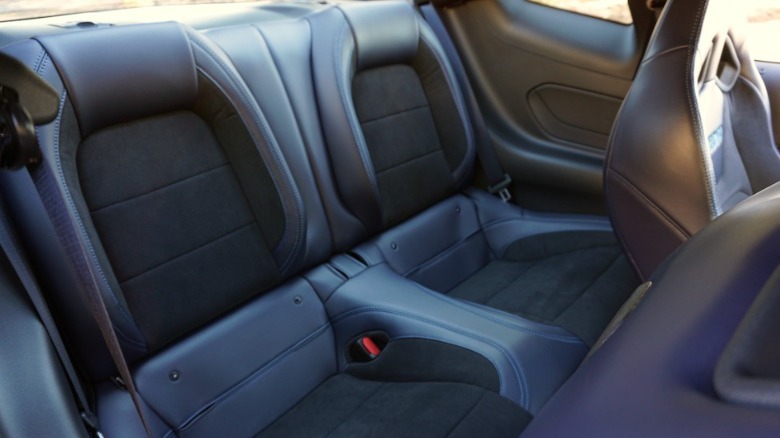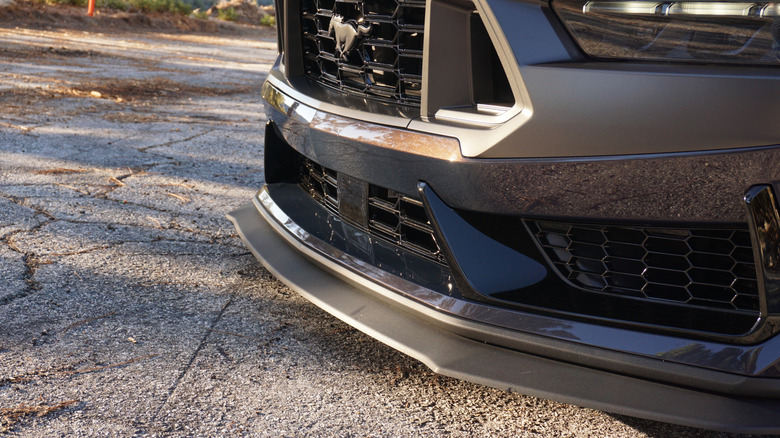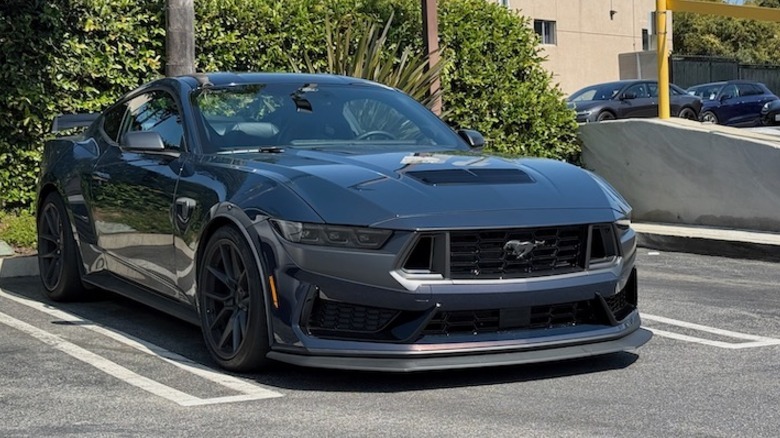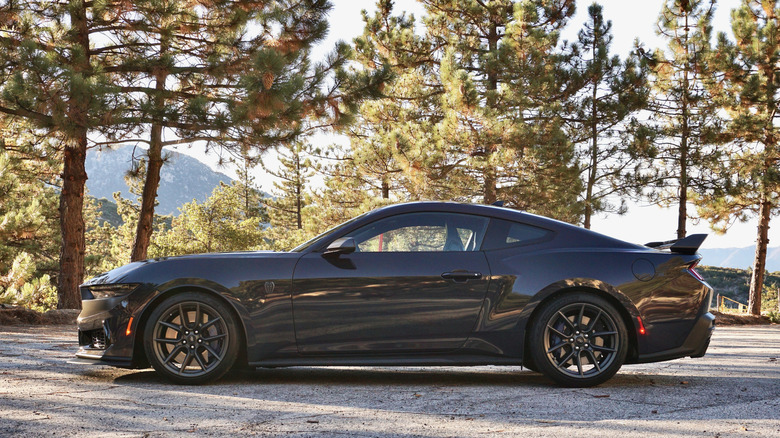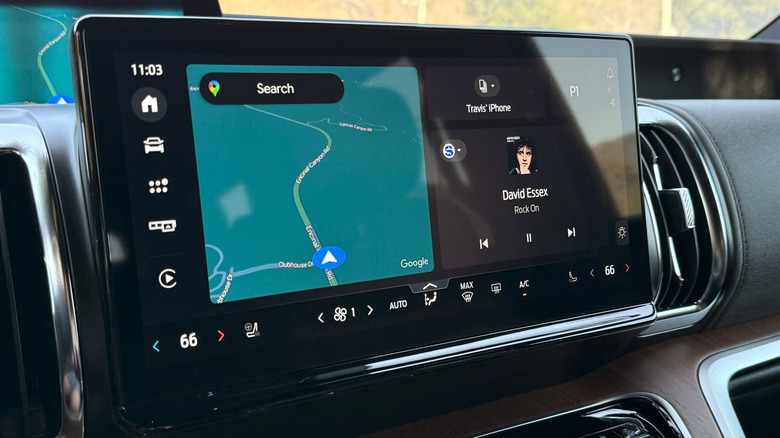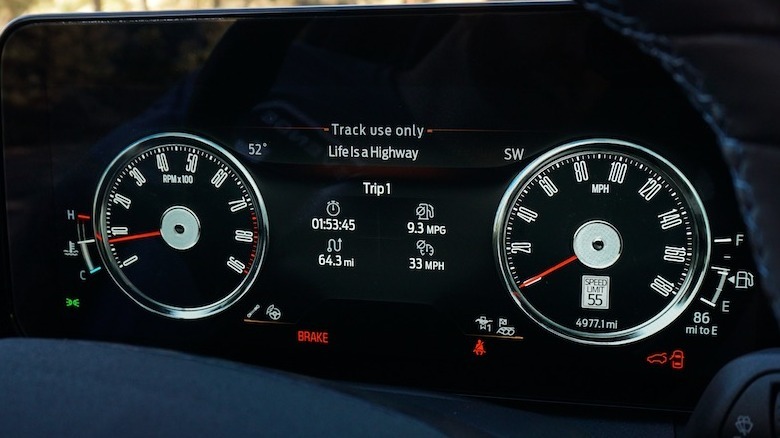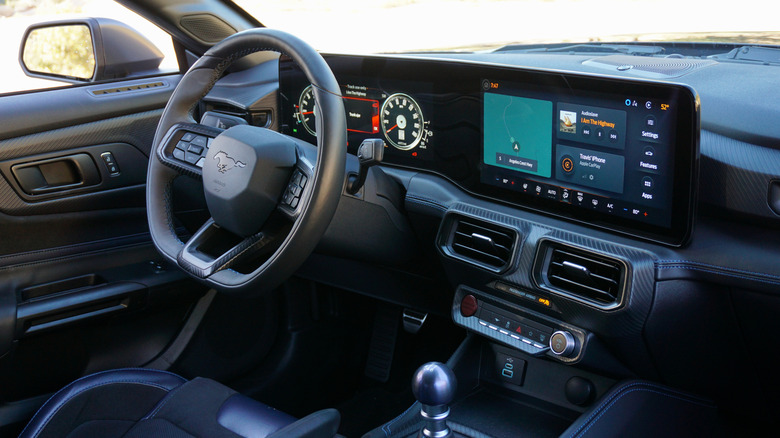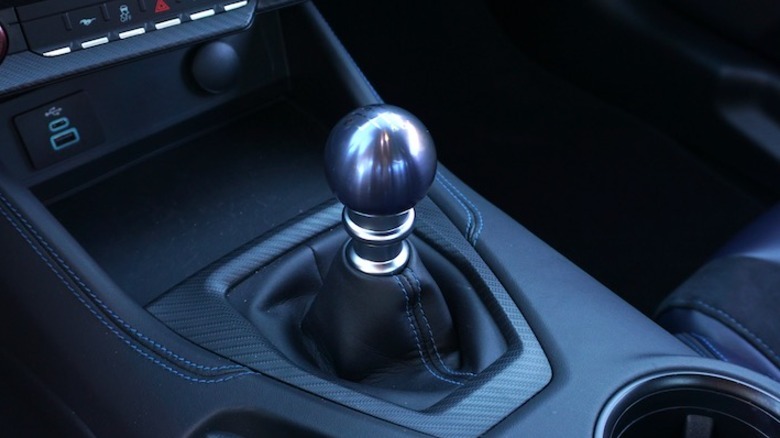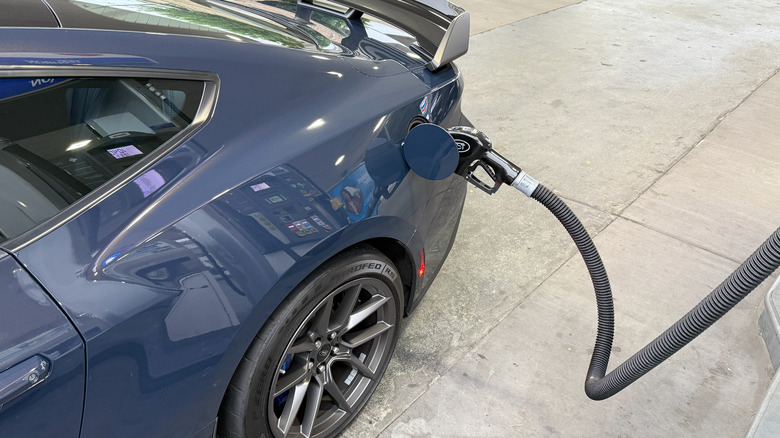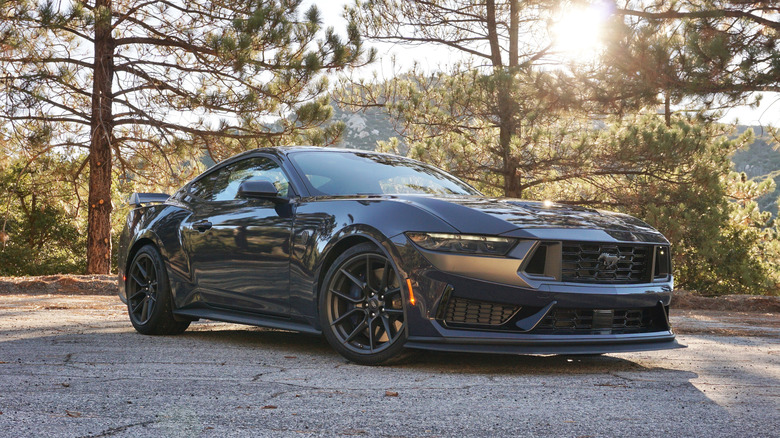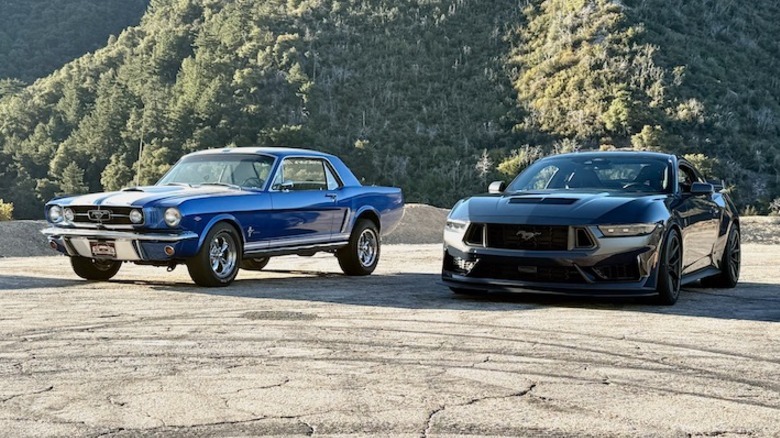Ford's Mustang Is A Survivor, And This Dark Horse Proves Why
It wasn't that long ago the market was full of muscle cars like the Chevrolet Camaro and the Dodge Challenger. There were V8s powering rear-wheel-drive coupes from all three of the big Detroit manufacturers, with big exhaust pipes and smoky burnouts as far as the eye could see. But these days, most muscle cars have gone the way of the dodo and the only pony car still holding on is the Ford Mustang.
More than just a straight-line muscle car, the latest Mustang is filled with modern features, it's properly agile on canyon roads, and comfortable enough to drive on a daily basis, even in its highest-performance trims. About as upscale as things get in the Mustang lineup is the Dark Horse Premium. It's got more horsepower than anything in the Mustang lineup (aside from the supercar-adjacent Mustang GTD of course), and the Dark Horse has just about every creature comfort you can think of. Ford loaned me a Dark Horse for a week to showcase just how mature it is, but my time behind the wheel proved that it's still a bit of hooligan at heart.
Lots of power and then some
The 5.0-liter V8 under the hood of the Mustang GT puts out 480 horsepower and 415 lb-ft of torque. Those figures go up a bit with the available active exhaust (486 and 418) but none of those numbers would suffice at the top of the lineup. Naturally, they pumped up the Dark Horse to a more appealing 500 horses. Torque stays a healthy 418, but that 500 just sounds so right.
The Dark Horse feels properly fast, too. I drove a standard Mustang GT just a few months back and there's definitely a different feel with the Dark Horse from behind the wheel. Nail the throttle and it heads towards the horizon with intent and a cacophony of noises from the active exhaust. The pops and bangs of the V8 blasting reward out of the four exhaust tips can be calmed down a bit with some adjustment of the settings, but I didn't bother with the quiet mode much: the Dark Horse is too much fun with all that noise.
Dark Horse models get an exclusive Tremec six-speed manual transmission, an upgrade from the standard Getrag MT-82 six-speed in the regular Mustang. The shifting action from the gear lever is smooth, even if the throws are a bit long for my liking. The clutch pedal is light enough that you can drive the Dark Horse in heavy traffic for a while without completely zapping the energy from your left leg.
Steering, handling, and braking
The Mustang's big V8 and the car's bulky nature leaves it feeling a bit less refined than cars like the svelte Porsche Cayman, but the Mustang is still engaging and entertaining to drive on curvy roads. It's a brute, but it's a cleanly-shaven brute in a three-piece suit with a really expensive watch. The weight of the Mustang's steering is appropriately heavy in the sportiest of modes, even if it isn't very direct. Being able to understand what the front wheels are doing isn't very intuitive. Thankfully, the steering wheel is a properly thick diameter and it feels great in my hands.
The Mustang feels properly large on tight roads and in general, it's a pretty big car, but it's not difficult to drive quickly. It has serious high-speed cornering grip via the Pirelli Trofeo RS tires and it feels stable in high-speed corners. Drive on a dirty road though, and you'll end up with lots of rocks and pebbles inside the wheels. Sticky rubber, it turns out, sticks to just about everything.
The Dark Horse's big Brembo brakes gave plenty of braking pressure, and only after repeated hard stops, could I feel them starting to lose their power a bit. Downshifting was a quick and easy operation with the excellent rev-matching system in the Dark Horse that I never bothered to turn off. Purists might turn up their noses at rev-match tech, but when it's executed this well, there's nothing to complain about.
Living with it as a daily driver
There's very little in the way of drawbacks when it comes to the Mustang's performance having an effect on ride comfort. MagneRide suspension, which is optional on lower trims of the Mustang but standard on the Dark Horse, absorbs a lot of the largest impacts on the open road, only letting in a few sharper impacts at speed. It's excellent in the corners and on the highway. There are some problems, however, related to its tires and alignment.
On the highway, the sticky Trofeo RS tires follow grooves and cracks. Driving in a straight line, on a straight freeway, without any slope or angle to the road, it's relatively easy to keep the Dark Horse on track. Any cracks or road imperfections, though, or changes in the slope of the road, and the Dark Horse darts several inches left or right.
Tramlining is probably the best word to describe this behavior, but I'd also call it darty and even unpredictable at times. Even when you're on a mostly-straight section of highway, you need to keep both hands firmly on the wheel, aware that the Dark Horse might quickly move left or right without warning. More than mildly unsettling, it's a compromise you have to make every time you drive the Mustang on the highway.
Spacious for two, a squeeze for four
There's enough room in the Mustang's front seat for drivers and passengers of just about any size. The optional Recaro seats are definitely comfortable too, with lots of bolstering and a medium-firm padding that's supportive but not overly stiff. On long, back-road jaunts with lots of corners, I didn't slide around at all, and on the highway over long miles I was just as comfortable.
A drawback of the comfy Recaros, however, is just how thick they are. Front to back, it felt like they took up an unnecessary amount of space, especially for seats that weren't heated or ventilated. The thickness of the seats, combined with the Mustang's low roof, high door sill and long doors, means getting in and out is a bit of a squeeze too — at least if I don't want to abandon pizza as a cornerstone of my diet.
Then there's the back seat, which is basically a glorified luggage area. Sure, you could probably fit a small child seat back there, but getting it in and out will be tough. And no average-sized adult will be able to spend time in the rear. I'm 5-foot-9 but behind my seating position there wasn't enough space for even a child's legs. Treat it like a luggage area though, and it's plenty of room, especially when you combine it with the 13.5 cubic feet of trunk space.
Ouch, that's the front splitter
Taking the Mustang Dark Horse in and out of my garage every morning was a bit more difficult than letting it breathe on an open highway. Functionally, I'm sure the Dark Horse's various aerodynamic body work does wonders. Driving it on a daily basis in a built-up city is a bit rough, comparatively. The front splitter in particular sticks out way in front of the front bumper, and it scrapes on even the calmest of driveway approach angles. If you're not careful, it would be pretty easy to catch the splitter on something low and cause some serious damage.
The Mustang also feels big at slow speeds, especially when it comes to navigating parking lots and tight spaces. Parking it often took several attempts and I took to pulling it in backwards almost exclusively so I could rely on the rearview camera rather than potentially tap the front splitter on a parking curb. Forward visibility is good enough on the highway, but the hood is long and barely slopes. That makes it tough to know where the Mustang's corners are from the driver's seat which isn't ideal when you're out grocery shopping. The Mustang's cabin is like a nice cocoon, but cocoons don't have great visibility.
Pricing covers a wide spread
The Mustang's pricing covers a lot of territory. Base EcoBoost models have a starting price of $35,010 (including $1,995 destination fee and $695 acquisition fee). That's a low enough price that coupes like the Subaru BRZ and Toyota GR86 could be considered proper rivals. Step up to the GT trim level with the Mustang's signature V8 and prices go up significantly: closer to $50,000 without breaking a sweat.
The Dark Horse, with its extra power and performance upgrades, has an MSRP of $66,770. Then, at the top of the ladder is the Dark Horse Premium, the car I tested. It starts at around $72,000, but with a considerable number of options equipped to my test car, the price ballooned to $81,550.
Options like the $5,485 Dark Horse Handling package (MagneRide, front splitter, rear spoiler with gurney flap, adjustable strut top mounts, unique 19x10.5" wheels) add the biggest chunks to the price tag, but little extras here and there — like the $200 floor mats — can probably be skipped. The most noticeable option was the color: Blue Ember. I received dozens of compliments specifically regarding the color over just one week of driving the Mustang. If you desire a bit of added joy when you see the special color of your car every morning in the sunlight, it's an option that's worth the price (it's part of the $2,100 Dark Horse Appearance Package). Just beware: strangers will sideline you to compliment you on the color just about every time you stop to fill up for gas.
Tech done right
Balancing the inclusion of modern features without distracting from the engaging experience of driving is a tight rope walk, but Ford has done a pretty good job with the overall user experience in the Mustang. The 13.2-inch center touchscreen is excellent. It's large enough and high-resolution enough that it's easy to see and operate, but it's low enough on the dashboard that it doesn't block the view ahead.
In a properly combined whimsical and nostalgic use of technology, Ford has developed graphics for the Mustang's gauges that replicate previous eras in the car's history. On the Mustang's 12.4-inch driver display, you can pick and choose gauge designs from some of the most popular Mustang eras. The 1960s Mustang gauges looked best to me, but there are several more-recent options too, including Fox Body gauges.
A 12-speaker B&O stereo is standard on the Dark Horse Premium and it has respectable audio quality in the lower half of the volume range, but it doesn't get nearly loud enough for my liking, nor does it maintain all of its audio quality as the volume increases to the top of the range. If I owned the Mustang, I'd probably head straight to my local audio shop for a stereo upgrade.
More than just nice screens
Along with the Mustang's modern screens comes some tech that does a pretty admirable job too. The Mustang's driver aids, like adaptive cruise control, are well tuned. There's a decent amount of distance maintained behind other cars with the adaptive cruise control engaged. Lane-keep assist worked well on the highway too, and when I wanted to tackle some corners and turn off the system, it was easy to deactivate.
A cool feature that only shows up on a few manual-transmission cars (at least that I can think of), is the Mustang's ability to maintain a set cruise control speed even through shifts. For example, if I set the cruise control to 70 mph and I'm heading uphill, bogging down a bit in sixth gear, I can quickly shift down to fifth gear without the cruise control disengaging. It means you don't have to re-set the cruise control every time I want to change gears, a bit like what would happen naturally if the car were equipped with an automatic.
Fuel is gonna cost you
Here's a bit of information that will surprise absolutely no one: when you drive a 5.0-liter Mustang with a heavy foot, you're gonna pay for it at the pump. And boy-oh-boy did I pay. I won't say exactly how much I get paid to write reviews of cars here at SlashGear, but I will say that the amount of fuel I put into the Mustang made this particular review a net negative. Thankfully, I think it was worth the price.
According to the EPA, the 2.3-liter four-cylinder Mustang can achieve as high as 26 mpg combined (22 city/33 highway). The V8-powered Mustang GT tops out at 19 mpg combined with the 10-speed automatic, while the Dark Horse falls even farther still to 17 mpg combined (with either transmission). The supercharged GTD is naturally much lower at 12 mpg combined, but it's a race car in street car clothing, so that's to be expected.
Several tanks of premium fuel were required to do the kind of fun, smile-inducing driving that the Mustang provides (and I was happy to oblige), plus I did a bit of commuting and grocery shopping, all while averaging single-digit fuel economy for most of the week. At a few points, when I relaxed my right foot and resisted the urge to play a V8-powered symphony with the loud pedal, the Mustang rewarded me with 12-13 mpg averages, but that wasn't super common.
2025 Mustang Dark Horse Premium verdict
If you still think of the Mustang as a pure muscle car, capable of only excelling at acceleration in a straight line, you're simply ignoring all the evidence to the contrary. It's a big, brash sports car, but it has most of the creature comforts you'd expect to see in the limited class of modern high-performance coupes. Sure, the top trim is expensive, but there are a lot of other versions of the Mustang that offer much of the same cool factor without the big price tag. It 5.0-liter V8 sounds fantastic, the fastback design looks as classically styled as ever, the interior feels relatively upscale.
There are some daily driving compromises like the tendency to tramline and the abysmal fuel economy, but they don't outweigh the Dark Horse's charm and performance capability. In a world where performance two-door vehicles are becoming less and less common, the Mustang is holding the line. It's not cheap to get nostalgia, performance, and comfort all in the same pony car package, but with the Dark Horse you get a lot for your money.
